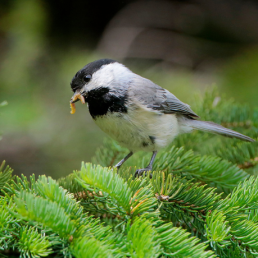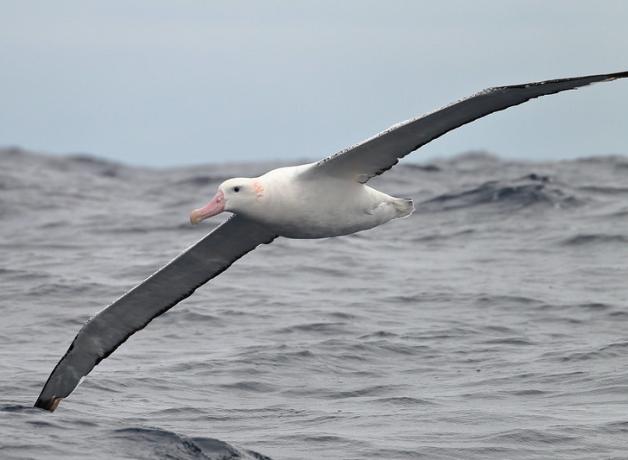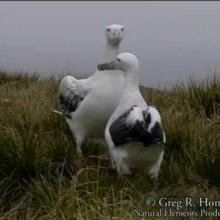BirdNote®
Wandering Albatross Molt
Written by Bob Sundstrom
This is BirdNote.
(American Robin ML133356 G Keller)
Most birds molt and regrow their flight or wing feathers—one at a time along each wing—to stay in prime condition for flying. For an American Robin with a 17-inch wingspan, that’s 23 feathers per wing, molted and regrown over two months, just after the nesting season. Every year.
Now let’s scale up to the wing molt of a Wandering Albatross, with a whopping 10- to 12-foot wingspan.
[Wandering Albatrosses calling, https://macaulaylibrary.org/asset/203922121, 0.16-.22]
Its long, narrow wings make the Wandering Albatross the largest flying bird — and an incredibly efficient flyer. Sure, its gangly wings are awkward when it takes off, but they’re ideal for soaring above the ocean. Once aloft, a Wandering Albatross rarely if ever flaps. A tendon locks in place in each wing, and it rides the air currents with little effort. These birds are supreme gliders.
(NatureSFX # 02 Wind-moderate-soft)
[Wandering Albatrosses calling, https://macaulaylibrary.org/asset/203922121, 0.16-.22]
With that gargantuan wingspan, it takes the large albatrosses a full year to molt, and they have to put off breeding until the next year. It’s one or the other.
Their long wings require a lot of time and energy, but they make the Wandering Albatross a true master of the wind.
For BirdNote, I’m Michael Stein.
###
Senior Producer: John Kessler
Production Manager: Allison Wilson
Producer: Mark Bramhill
Associate Producer: Ellen Blackstone
Bird sounds provided by The Macaulay Library of Natural Sounds at the Cornell Lab of Ornithology, Ithaca, New York. American Robin ML 133356 Recorded by G Keller. Wandering Albatross ML 203922121 Recorded by J Del Hoyo. Wind SFX recorded by Gordon Hempton.
BirdNote’s theme was composed and played by Nancy Rumbel and John Kessler.
© 2021 BirdNote April 2021 Narrator: Michael Stein
ID# WAAL-01-2021-04-12 WAAL-01
https://blogs.bu.edu/biolocomotion/2011/12/13/the-wandering-albatross/
https://pubmed.ncbi.nlm.nih.gov/15536648/
http://slatermuseum.blogspot.com/2010/09/different-molt-strategies.html
https://www.allaboutbirds.org/news/the-basics-feather-molt/






